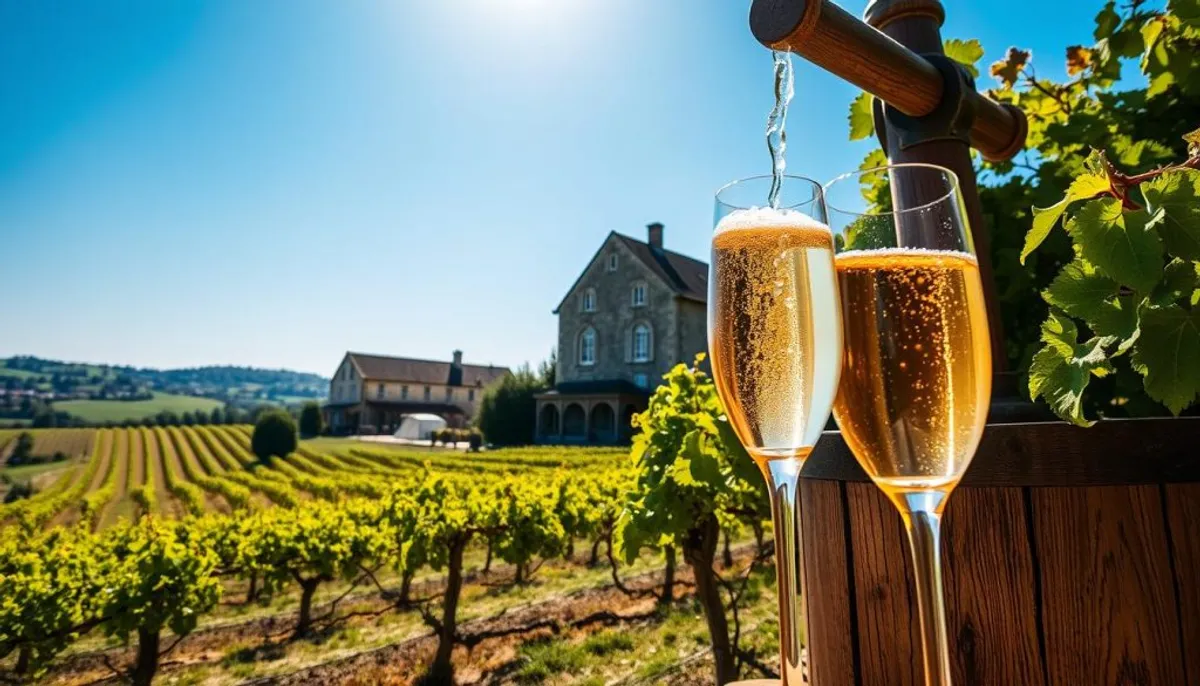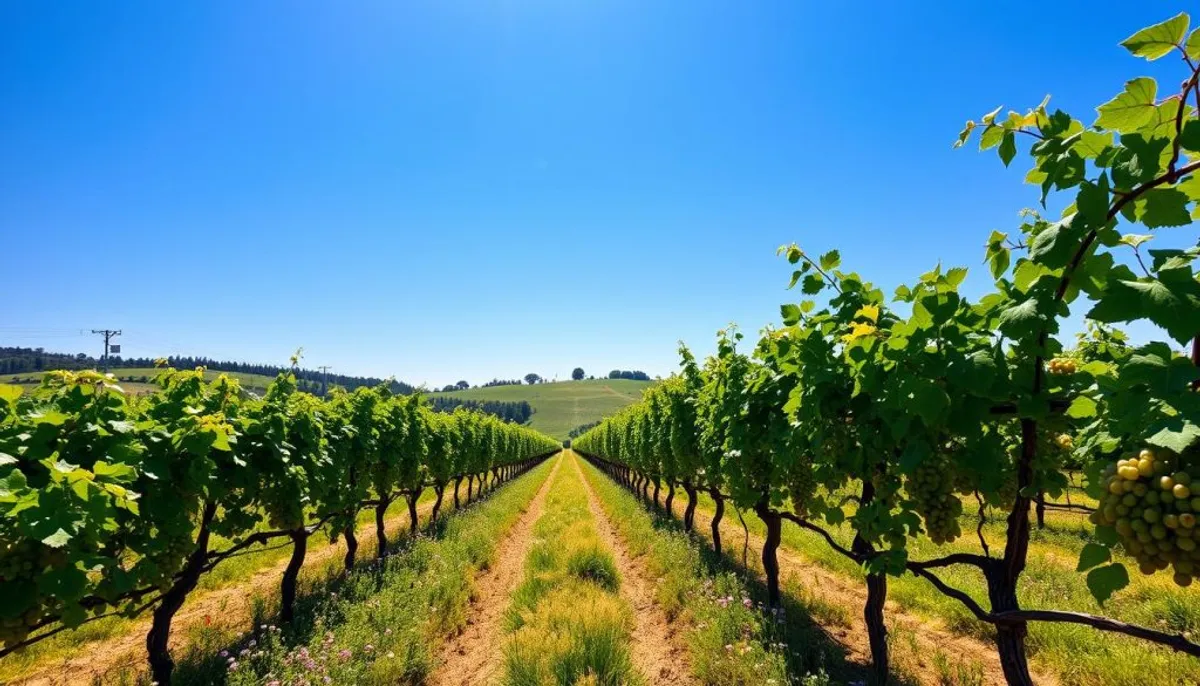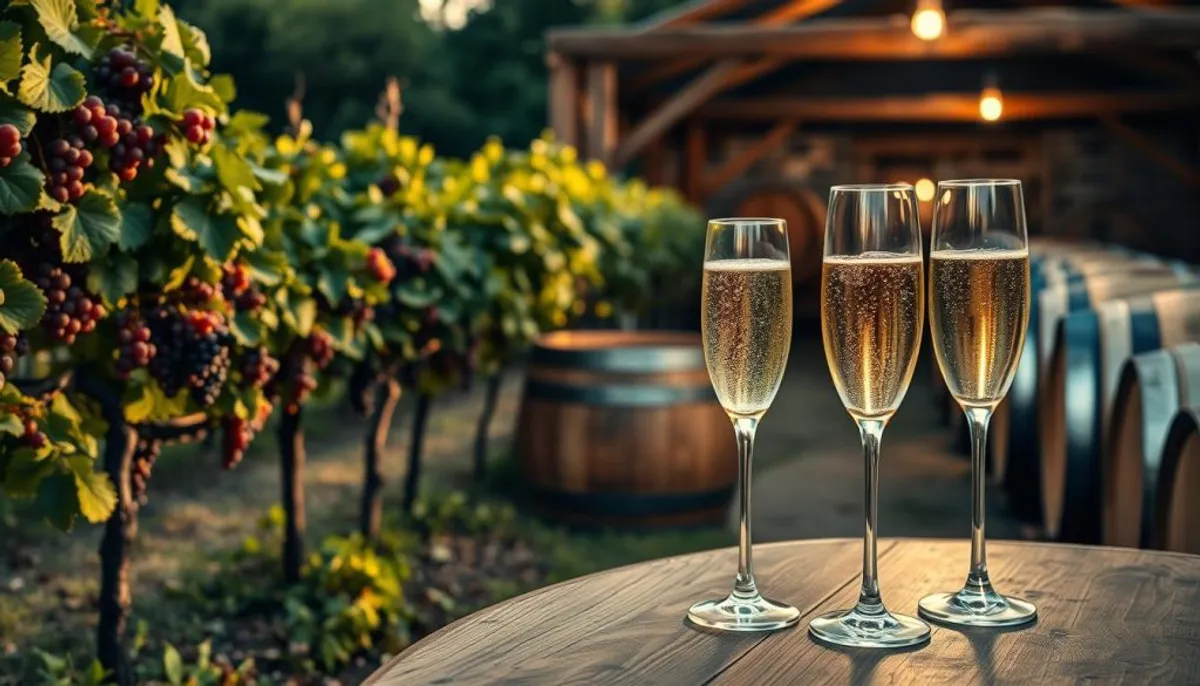In the heart of Landreville, Aube, Charles Dufour Champagne shines as a paragon of artisanal excellence in the realm of sparkling wines. Spanning 6 hectares, this estate has distinguished itself through its unwavering commitment to biodynamic champagne production and the expression of terroir.
Since 2010, Charles Dufour has adhered to organic practices, yielding a collection of cuvées that embody the Aube region’s essence. The distinctive composition of 60% Pinot Noir, 30% Chardonnay, and 10% Pinot Blanc distinguishes these effervescent creations from conventional Champagne houses.

With nearly 90% of its output destined for international markets, Charles Dufour has earned international acclaim for its Bistrøtage line and Ballade of the Villages series. These artisanal French champagnes exemplify the potential of small-scale, terroir-focused winemaking in Champagne, including the production of small-batch champagne.
Key Takeaways
- Charles Dufour Champagne is produced on a 6-hectare estate in Landreville, Aube.
- The estate follows biodynamic practices and is certified organic.
- A unique blend of 60% Pinot Noir, 30% Chardonnay, and 10% Pinot Blanc is used.
- The Bistrøtage line and Ballade of the Villages series are signature collections.
- Nearly 90% of Charles Dufour’s production is exported globally.
- The champagne emphasizes terroir expression and artisanal craftsmanship.
The Legacy of Charles Dufour in Landreville
Charles Dufour, a Landreville winemaker, represents the vanguard of artisanal Champagne producers. His odyssey in the realm of sparkling wines commenced in 2006, when he assumed control of his family’s vineyards. Now, Dufour serves as a paragon of innovation within the Aube Champagne region.
From Family Heritage to Independent Winemaking
Dufour’s narrative is one of metamorphosis. He transformed his family’s vineyard into a flourishing independent venture. His unwavering commitment to excellence is reflected in each bottle crafted on his 6-hectare estate.
The Aube Region’s Rising Star
Dufour has emerged as the champion of the Aube Champagne area. His distinctive winemaking methodology has earned him the moniker “Selosse of Aube,” a testament to his ascension among Champagne producers.
Evolution of the 6-Hectare Estate
Dufour’s estate has evolved into a paradigm of sustainable winemaking. He now cultivates, presses, vinifies, and sells his own Champagne, exemplifying the full potential of his Landreville terroir.
| Aspect | Details |
|---|---|
| Estate Size | 6 hectares |
| Farming Method | Organic (100%) |
| Average Wine Price | £26.80 |
| Alcohol Content | 13.8% (average) |
| Oak Barrel Aging | 37.5% of wines |
Understanding Charles Dufour Champagne
Charles Dufour Champagne distinguishes itself in the champagne industry through its dedication to artisanal methods and the expression of terroir. Since 2013, Dufour has adopted organic practices on his 6-hectare estate. This commitment to sustainable viticulture is a testament to his dedication to the craft.
The unique blend composition of Charles Dufour’s champagnes exemplifies his innovative approach. For example, the Bulles de Comptoir #12 is a blend of 60% Pinot Noir, 30% Chardonnay, and 10% Pinot Blanc. This combination creates a distinctive flavor profile that embodies the essence of the Aube region.
Dufour’s artisanal methods are evident in his winemaking process. The champagne undergoes a 15-month lees aging during secondary fermentation, which enhances its complexity and depth. This meticulous attention to detail is also evident in his other creations, such as the Bistrotage B19. This wine features Pinot Noir directly pressed into barrels for fermentation.
| Cuvée | Blend | Production Method |
|---|---|---|
| Bulles de Comptoir #12 | 60% Pinot Noir, 30% Chardonnay, 10% Pinot Blanc | 15 months on lees |
| Bistrotage B19 | Pinot Noir dominant | Direct press into barrel |
| Vin de Comptoir | Solera blend (2010-2018) | No fining, filtration, or SO2 |
Charles Dufour’s champagne production embodies a harmonious blend of tradition and innovation. This results in wines that authentically represent the terroir of the Aube region.
Organic Certification and Sustainable Practices
Charles Dufour’s dedication to organic champagne production is a beacon in the Champagne region. Since 2010, his estate has been fully certified organic. This marks a pivotal shift in the area’s viticultural practices.
Conversion to Organic Farming
Dufour began transitioning to organic farming in 2006, achieving full certification by the 2010 harvest. This move reflects a broader trend in Champagne, where 20% of vineyard areas now hold environmental certifications. The transition to sustainable viticulture has resulted in a 20% reduction in the carbon footprint per bottle of champagne.
Challenges in Organic Viticulture
Organic farming in Champagne encounters unique challenges due to its cold, rainy climate. Despite these hurdles, Dufour has successfully crafted high-quality organic champagnes. His approach includes utilizing native yeasts for fermentation and maintaining a perpetual blend system. This sparkling wine guide showcases the potential of organic methods in challenging conditions.
Environmental Impact and Benefits
The adoption of organic and biodynamic practices has brought significant environmental benefits. The Comité Champagne aims to reduce the collective carbon footprint by 25% by 2025 and 75% by 2050. Dufour’s efforts align with these goals, proving that sustainable viticulture can produce exceptional champagnes while preserving the environment.
| Sustainable Practice | Impact |
|---|---|
| Organic Certification | Achieved in 2010 |
| Native Yeast Usage | Enhances terroir expression |
| Perpetual Blend System | Maintains consistency across vintages |
| Reduced Chemical Use | 50% decrease in phytosanitary products |

Unique Blend Composition
Charles Dufour’s Champagne blend is distinguished by its unique composition. The winemaker crafts a blend that diverges from traditional Champagne houses. This sets his bubbles apart.
Pinot Noir Dominance
Pinot Noir is the dominant grape in Dufour’s blend, making up 60%. It lends structure and body to the Champagne. This creates a robust foundation for the other components.
Chardonnay Integration
Chardonnay constitutes 30% of the blend. It brings elegance and finesse to the Champagne. This balances the strength of Pinot Noir with its lighter, more delicate notes.
Rare Pinot Blanc Addition
The final 10% is comprised of Pinot Blanc, a rare choice in Champagne blends. This grape adds a unique character to Dufour’s wines. It sets them apart from many other producers in the region.
| Grape Variety | Percentage | Contribution to Blend |
|---|---|---|
| Pinot Noir | 60% | Structure and body |
| Chardonnay | 30% | Elegance and finesse |
| Pinot Blanc | 10% | Unique character |
This careful balance of grape varieties results in a Champagne that offers complexity and depth. The Bulles de Comptoir #6 La Benjamine 2.0 Extra Brut exemplifies this blend. It has a base from the 2015 vintage, enriched by reserve wines from a perpetual blend dating back to 2010, including the renowned gh mumm.
Dufour’s approach to blending reflects a growing trend in the Aube region. Growers are increasingly recognizing the quality of Pinot Blanc. This innovative spirit, combined with organic farming practices, results in a Champagne that truly captures the essence of its terroir.
Production Methods and Philosophy
Charles Dufour’s Champagne production reflects the core of artisanal winemaking. His approach focuses on minimal intervention and natural fermentation. This allows the distinct terroir of Landreville to be showcased in every bottle.
Dufour personally oversees every step of production, from cultivating grapes to bottling. His dedication to quality and authenticity is evident in every detail, including the innovative techniques inspired by xavier laluc. This hands-on method ensures that each step is meticulously aligned with his high standards.
The winemaking process at Charles Dufour Champagne adheres to the traditional champenoise method. This involves two fermentations. The second fermentation, essential for the iconic bubbles, can last from ten days to three months. To enhance your champagne experience, consider using ekaani champagne glasses for the perfect presentation.
| Production Aspect | Charles Dufour Approach | Industry Standard |
|---|---|---|
| Fermentation | Natural, minimal intervention | Often controlled |
| Grape Selection | Hand-picked, estate-grown | Varies by producer |
| Aging on Lees | Extended period | Minimum 15 months |
| Dosage | Minimal to zero | Varies by style |
Dufour’s commitment to artisanal winemaking is also evident in his aging process. While the industry standard requires at least 15 months on lees, Dufour extends this period. This allows his Champagnes to develop richer complexity and character.
Signature Collections and Cuvées
Charles Dufour’s cuvées exemplify the winemaker’s skill and commitment to organic viticulture. These champagnes reflect the unique terroir of the Aube region, presenting a variety of exceptional wines.
Bistrøtage Line
The Bistrøtage line is a testament to Dufour’s dedication to organic viticulture. These champagnes are made from organic Pinot Noir grapes, sourced from vineyards tended by Dufour’s mother. The Bistrøtage cuvées capture the essence of artisanal French bubbles, emphasizing purity and expression.
Ballade of the Villages Series
The Ballade of the Villages series represents Dufour’s pinnacle of craftsmanship. This line includes a Brut Nature champagne that undergoes an impressive 18-year aging process on lees. This extended aging contributes to a complex and nuanced flavor profile, distinguishing it in the world of artisanal champagnes.
Limited Edition Releases
Dufour’s portfolio also includes limited edition releases that showcase his innovative spirit. These unique cuvées offer wine enthusiasts the chance to experience rare and experimental blends. This further solidifies Charles Dufour’s reputation in the champagne world.

| Collection | Key Feature | Aging Process |
|---|---|---|
| Bistrøtage | Organic Pinot Noir | Standard |
| Ballade of the Villages | Brut Nature | 18 years on lees |
| Limited Editions | Experimental blends | Varies |
With only 3.5% of Champagne’s vineyards dedicated to organic farming, Dufour’s commitment to sustainable practices distinguishes his cuvées. His focus on small-scale distribution to natural wine bistrots ensures these exceptional champagnes reach appreciative audiences.
Technical Specifications and Quality Markers
Charles Dufour Champagne is renowned for its adherence to champagne specifications. The winery’s dedication to quality is evident in every bottle. This commitment ensures that each bottle meets the highest standards.
ABV and Dosage Details
Dufour’s champagnes typically have an alcohol by volume (ABV) of 12.5%. They are classified as extra brut, with dosage levels ranging from 0 to 6 grams per liter. This approach showcases the fruit’s purity and the terroir’s essence.
Aging Process
Lees aging is crucial in developing the complex flavors of Charles Dufour Champagne. Some cuvées, like the Ballade of the Villages Brut Nature, spend up to 18 years in the cellar. This extended contact with lees enriches the wine’s depth and character.
| Specification | Detail |
|---|---|
| ABV | 12.5% |
| Dosage Classification | Extra Brut |
| Dosage Range | 0-6 g/L |
| Maximum Lees Aging | Up to 18 years |
The extended lees aging process significantly enhances the champagne’s complexity. It improves the wine’s texture, creating a creamy mouthfeel. This adds layers of flavor. Charles Dufour Champagne’s aging process sets it apart in the world of fine sparkling wines.
Global Recognition and Distribution
Charles Dufour’s artisanal champagne has made a significant impact on the international market. His winery exports an impressive 90% of its production, highlighting the robust trends in champagne export for boutique producers. This figure clearly demonstrates the escalating demand for artisanal champagnes globally.
The international allure of Dufour’s champagnes is evident in their rarity. Despite an increase in production, these wines remain scarce across the globe. This scarcity paradoxically boosts their desirability, creating a cycle of high demand and limited supply.
Dufour’s success in the global market is not an isolated phenomenon. The Aube region, home to his vineyard, has emerged as a hub for exceptional champagne production. Producers like Gautherot, Valérie Frison, and Cédric Bouchard have collectively enhanced the region’s reputation. This has contributed to its growing stature in the champagne world.
The global recognition of Charles Dufour Champagne mirrors a broader trend in the wine industry. Consumers are now gravitating towards unique, artisanal products, driving demand for small-batch champagnes like the southland champagne collection and jean laurent champagne. This shift in preference has opened new avenues for boutique producers like Dufour in the competitive global wine market.
Tasting Notes and Wine Characteristics
Charles Dufour Champagne presents a unique flavor profile, captivating wine enthusiasts. The tasting notes reveal a complex, nuanced experience. This showcases the artistry behind each bottle.
Visual Appearance
In the glass, Charles Dufour Champagne is mesmerizing. It displays a pale golden hue with fine, persistent bubbles. These bubbles dance to the surface, setting the stage for the sensory journey ahead.
Aromatic Profile
The nose of Charles Dufour Champagne is rich and inviting. It offers a bouquet of ripe orchard fruits, citrus zest, and delicate floral notes. As the wine opens up, subtle hints of brioche and toasted nuts emerge, adding depth to the aromatic experience.
Palate Expression
On the palate, Charles Dufour Champagne truly shines. The wine characteristics include a harmonious blend of freshness and maturity. Crisp acidity balances perfectly with the creamy texture, while flavors of green apple, lemon, and white peach dance across the tongue.
| Aspect | Description |
|---|---|
| Body | Medium to full-bodied |
| Acidity | Vibrant and well-balanced |
| Finish | Long and elegant with mineral notes |
| Food Pairing | Seafood, poultry, soft cheeses |
The extended lees aging imparts a luxurious creaminess and subtle yeasty notes. This elevates the overall tasting experience. The finish is long and memorable, leaving a lasting impression of the Landreville terroir.
Conclusion
Charles Dufour’s artisanal champagne emerges as a beacon in the dynamic realm of French sparkling wines. His estate, spanning 6 hectares in Landreville, exemplifies the pinnacle of organic viticulture in Champagne. Dufour’s unwavering dedication to terroir-driven wines is evident in each bottle, capturing the essence of the Aube region.
The unique blend of Pinot Noir, Chardonnay, and rare Pinot Blanc distinguishes Dufour’s champagnes. These wines, benefiting from extended aging and limited production, have garnered global recognition for their unparalleled quality. The increasing demand for Dufour’s artisanal champagne underscores a burgeoning interest in small-batch, terroir-focused producers.
In the evolving champagne industry, Charles Dufour is at the forefront, championing sustainable practices and innovative winemaking. His commitment to organic methods, despite the challenges posed by Champagne’s climate, demonstrates that quality and environmental stewardship are not mutually exclusive. Dufour’s journey serves as a beacon for the next generation of artisanal champagne makers, who seek to redefine tradition while honoring their heritage.
RelatedRelated articles



